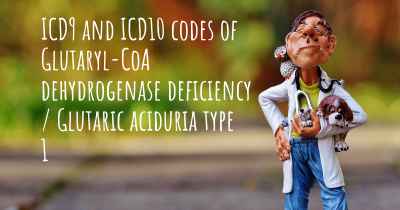What is the life expectancy of someone with Glutaryl-CoA dehydrogenase deficiency / Glutaric aciduria type 1?
Life expectancy of people with Glutaryl-CoA dehydrogenase deficiency / Glutaric aciduria type 1 and recent progresses and researches in Glutaryl-CoA dehydrogenase deficiency / Glutaric aciduria type 1

Glutaryl-CoA dehydrogenase deficiency, also known as Glutaric aciduria type 1, is a rare genetic disorder that affects the body's ability to break down certain amino acids. This leads to a buildup of toxic substances in the brain, causing damage over time. The severity of symptoms can vary widely, ranging from mild developmental delays to severe neurological problems.
The life expectancy of individuals with Glutaryl-CoA dehydrogenase deficiency depends on various factors, including the age of diagnosis, the effectiveness of treatment, and the presence of complications. With early detection and appropriate management, including a low-protein diet and medications, individuals can have improved outcomes.
However, it is important to note that Glutaric aciduria type 1 is a chronic condition that requires lifelong management. Regular monitoring and medical care are essential to minimize the risk of complications and optimize the individual's quality of life.
Glutaryl-CoA dehydrogenase deficiency (GCDH) or Glutaric aciduria type 1 (GA1) is a rare genetic disorder that affects the body's ability to break down certain amino acids, specifically lysine, hydroxylysine, and tryptophan. This metabolic disorder is caused by a deficiency of the enzyme glutaryl-CoA dehydrogenase, which is responsible for breaking down these amino acids.
GA1 is an autosomal recessive disorder, meaning that both parents must carry a mutated gene for their child to be affected. The condition is estimated to occur in approximately 1 in 40,000 to 100,000 newborns worldwide, making it relatively rare.
Symptoms of GA1 typically appear in infancy or early childhood, usually between the ages of 3 months and 3 years. The initial signs may include poor feeding, vomiting, and low muscle tone. As the disease progresses, affected individuals may experience developmental delays, muscle stiffness, involuntary movements, and seizures. If left untreated, GA1 can lead to irreversible brain damage.
Early diagnosis and treatment are crucial in managing GA1. Newborn screening programs in many countries have been implemented to detect the disorder early on, allowing for prompt intervention. The screening involves a blood test that measures the levels of certain metabolites, such as glutaric acid, which are elevated in individuals with GA1.
Treatment for GA1 primarily focuses on a strict dietary regimen and close monitoring of the affected individual's metabolic status. The main goal is to prevent the accumulation of toxic metabolites that can damage the brain. This is achieved through a low-protein diet, which restricts the intake of lysine, hydroxylysine, and tryptophan. Additionally, supplementation with specific vitamins and carnitine may be recommended to support overall health.
Prognosis and life expectancy for individuals with GA1 can vary depending on several factors, including the severity of the condition, age at diagnosis, and adherence to treatment. With early detection and appropriate management, the long-term outlook for individuals with GA1 has significantly improved over the years.
Studies have shown that individuals who receive early treatment and adhere to the recommended dietary restrictions have a better prognosis. They are less likely to experience acute metabolic crises and are at a reduced risk of developing severe neurological complications. Regular monitoring of metabolic markers and neurodevelopmental assessments are essential to ensure optimal management.
While GA1 is a lifelong condition, advancements in medical understanding and treatment have led to improved outcomes for affected individuals. With proper management, many individuals with GA1 can lead relatively normal lives, achieve developmental milestones, and participate in regular activities.
It is important to note that each case of GA1 is unique, and the prognosis can vary. Some individuals may experience milder symptoms and have a better long-term outlook, while others may face more challenges. Close collaboration between healthcare professionals, genetic counselors, and families is crucial in providing personalized care and support.
In conclusion, Glutaryl-CoA dehydrogenase deficiency or Glutaric aciduria type 1 is a rare metabolic disorder that affects the body's ability to break down certain amino acids. Early diagnosis through newborn screening and prompt treatment are key in managing the condition. With appropriate dietary restrictions and close monitoring, individuals with GA1 can have improved outcomes and lead fulfilling lives. However, it is important to remember that each case is unique, and ongoing medical care is essential for optimal management.








